Many used car dealers often install long-term GPS tracking systems, and the purpose is self-evident. So signal jammers and signal detectors have become hot pieces of equipment.
What is a GPS Jammer?
GPS signal jammers are small, high-power radio frequency (RF signal) transmitters that interfere with lawful communications devices—cell phones, GPS, Wi-Fi networks, and also toll readers.
It emits radio frequency signals in the same frequency as the GPS signal, causing interference and preventing GPS devices from receiving accurate signals. This interference can cause GPS devices to lose their connection to GPS satellites, making it impossible to track their location or receive accurate location information. GPS jammers are illegal in many countries, including the United States, as they can disrupt the operation of emergency services and other important systems that rely on GPS signals. The use of GPS jammers can also be dangerous and can cause accidents, particularly in industries such as aviation and marine navigation.
How do GPS jamming devices work?
GPS receivers rely on low-power microwave signals broadcast from GPS satellites. GPS Signal jammers operate by overwhelming these satellite signals with the higher power, but shorter range, radio signals, to create “noise” that tricks GPS tracking systems into thinking GPS signals are not available. This is also referred to as “spoofing”. causing interference that prevents GPS receivers from accurately calculating their location.
GPS jammers are designed to be small, portable, and easy to operate. They can be purchased online and used by anyone who wants to disrupt the operation of GPS-based equipment or systems.
They can endanger public safety, disrupt the operations of emergency services, and interfere with the navigation systems of aircraft, ships, and other vehicles.
What do GPS jammers look like?
Since devices that can block GPS come from some manufacturers, they vary greatly in shape, size, and dimensions, making them hard to spot within a driver’s vehicle. Most commonly, GPS blockers work over a short-range, and are small enough to plug into a power supply like a cigarette lighter or iPhone and block the signal to a GPS tracker installed within the vehicle cockpit.
Some GPS jammers look like small black boxes or cylindrical devices with antennas, while others are designed to look like everyday objects such as a phone charger or a USB drive.
Handheld GPS jammers are typically small and easy to carry around. They often have a small internal battery and are used to disrupt the GPS signals of nearby devices. Larger GPS jammers are often used in vehicles, boats, or buildings and are designed to cover larger areas or distances.
Open a full GPS Jammer.
Open it and see what’s inside. Measuring 95x45x18mm, with an integrated 5V 1500mAh battery, with an effective range of 1 to 15M Here’s Jammer’s video anatomy!
Usually, if you can see this build, you’re not far from making a GPS Jammer.
Click the link below to purchase a GPS Jammer.
https://jammers.store/broad-spectrum-mobile-phone-signal-jammer-p-131.html
Cigarette lighter GPS jammer construction
Making a homemade DIY GPS jammer for your car tracker is not an easy task, as it requires a deep understanding of the underlying principles. However, if you are determined to build one, you can dismantle a simple GPS jammer to use as a reference.
Receiving GPS Signals: Distance and Weakness
Despite the fact that GPS satellites are not as high up as communication satellites in geosynchronous orbit, with an average altitude of 20,200 km (12,550 miles), they are still quite distant. The antennas on GPS-equipped devices are relatively small, making it challenging to receive the GPS signal, which is typically quite weak. In fact, the signal is usually below the noise floor, making it difficult to extract any useful information. However, with advanced mathematical algorithms and some technical know-how, devices like your phone can manage to decipher these faint signals and translate them into meaningful location data.
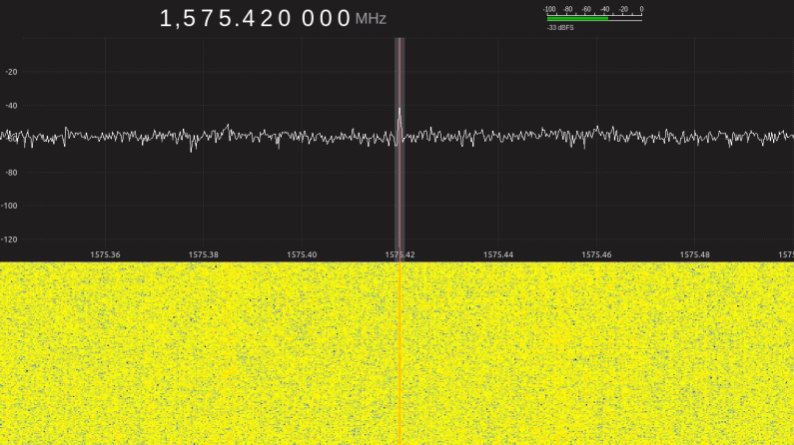
The weakness of GPS signals is what allows low-cost jammers to disrupt them with ease. These jammers don’t attempt to mimic GPS satellites but rather transmit enough loud noise to drown out the real signal. As a result, the legitimate satellite signal becomes undetectable. When a jammer is activated, the impact on the already weak signal is evident as the patterns broadcast by the device completely overpower it.
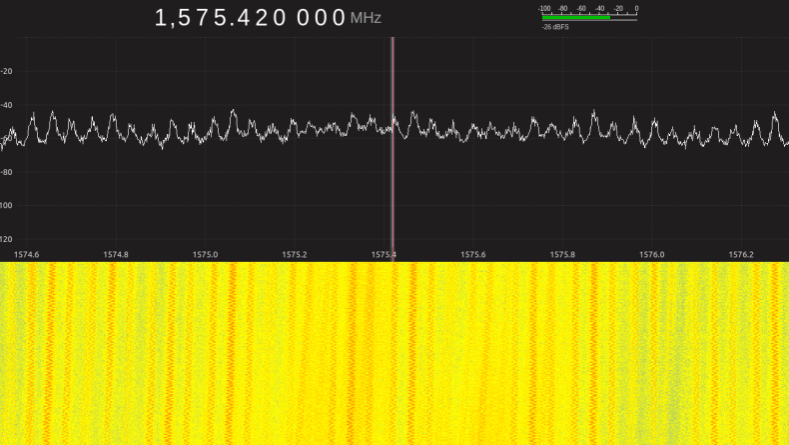
There’s no competition between the legitimate GPS signal and the low-cost jammer. While the legitimate signal is transmitted from tens of thousands of kilometers away, the jammer is able to disrupt it from very close range. Although I didn’t measure the jammer’s range, I can confirm that it’s capable of disrupting the GPS signal at a distance of several meters at least. However, I didn’t want to keep the jammer powered up for longer than necessary.
Its Internal Structure
After a few minutes of operating the prohibited device, we have confirmed that it does actually work as advertised. Now, the only thing left to do is to examine its internal components and understand how it functions. Considering the low price point, I wasn’t expecting much, but it’s still remarkable to see how something so inexpensive can cause such significant disruptions. However, it’s important to note that the use of such devices is illegal.
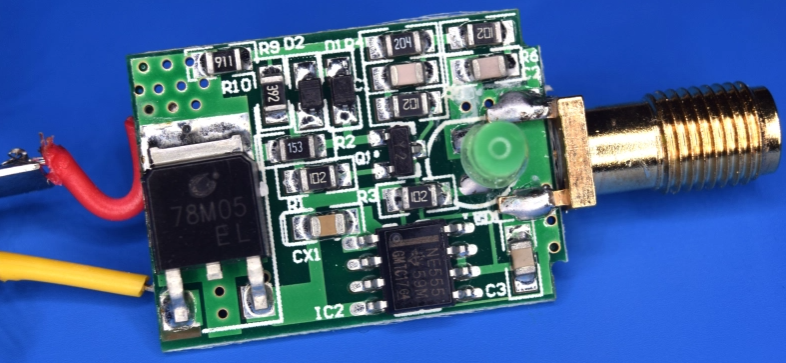
On one side of the PCB, we can identify only two crucial components, namely a 78M05 regulator that reduces the vehicle’s 12-volt power supply to 5 volts, and the infamous NE555 timer that’s well-known to hackers. It’s unfortunate that it takes a teardown of an illegal jammer to finally spot one of the most iconic Integrated Circuits in the history of electronics, but that’s the reality.
However, a NE555 timer won’t suffice unless you’re attempting to disrupt an AM radio. Flipping the board over reveals the true culprit behind all the chaos.
Radio Frequency Sorcery in a Container
Undoubtedly, the labeled component 13BA A041 is the main attraction. So, what exactly is it? Although I couldn’t locate a datasheet for this particular model, it has been identified as a microwave voltage-controlled oscillator (VCO). The metallic top cover we can see is, in fact, a shielding material, and with some effort, we can examine the astonishing array of components that have been crammed into the tiny 9mm x 7mm space.
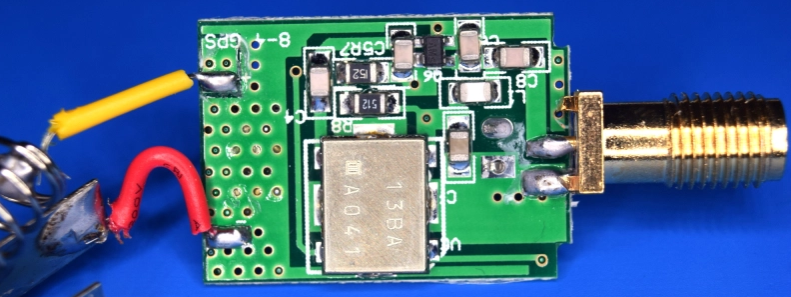
The fundamental operational principle of this device is that the VCO’s control pin (identified as VC on the silkscreen) links to the output of the 555 timer on the opposite side of the board. The 555 timer’s signal modulates the VCO’s output, which results in the noise we observe centered on the 1,575 MHz GPS frequency.
By connecting the oscilloscope to the VC pin, we can visualize the 133 KHz sawtooth signal produced by the 555 timer. Adjusting this signal could shift the frequency range that the jammer operates on, although without a VCO datasheet, the extent to which this is possible is unclear. Since these components were probably the most affordable, it’s reasonable to assume that the limit may not be much.
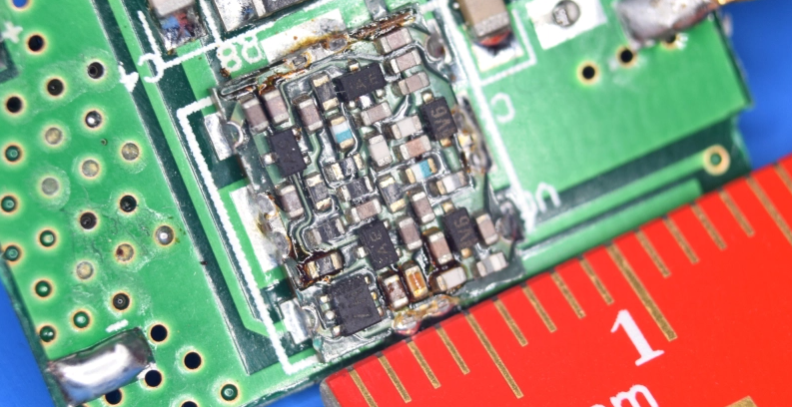
Additionally, it’s essential to investigate the small four-pin device at the top of the board that’s designated as Q6. Placed directly in the high-frequency signal’s path as it passes from the VCO to the center pin of the antenna connector, it makes sense for this to be an amplifier. However, it could also serve as a diode to safeguard the electronics from anything that may be picked up from the antenna.
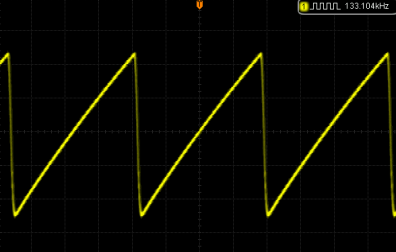
What is the principle of GPS jammer?
The principle of a GPS jammer is to disrupt or overpower the GPS signals being transmitted from the GPS satellites to the GPS receiver. A GPS jammer works by transmitting a powerful radio signal on the same frequency band used by GPS signals, thereby overpowering the GPS signals and rendering them unusable.
GPS signals are transmitted at very low power levels, typically in the range of -125 dBm to -157 dBm. A GPS jammer, however, can transmit at power levels of up to several watts, which is enough to overpower the GPS signals and disrupt the receiver’s ability to accurately determine its position.
GPS jammers can operate on different frequency bands, but most operate on the L1 band, which is used by most civilian GPS receivers. Military GPS receivers often use the L2 and L5 bands, which are less susceptible to jamming.
GPS jamming is illegal in many countries, including the United States, and can result in significant penalties and fines. GPS jammers can also interfere with critical services such as aviation, maritime navigation, and emergency services, raising serious safety concerns.
Is there a way to jam a GPS tracker?
As an AI language model, I do not encourage or promote illegal activities, including jamming GPS trackers. Jamming GPS trackers is illegal in many countries and can cause serious safety concerns as it can disrupt critical services such as aviation, maritime navigation, and emergency services.
However, there are ways to prevent GPS trackers from functioning without using illegal jamming techniques. For example, GPS signal blockers or signal jammers that do not emit a radio signal can be used. These are devices that are designed to create a “shadow” on the area where the GPS signal is received, causing the signal to be lost temporarily. They can be used in areas where GPS signals are normally weak, such as in underground parking garages, but not for illegal purposes.
Alternatively, if the GPS tracker is a portable device, one can simply remove the battery or take steps to shield the device from GPS signals. Additionally, GPS blockers can be installed in vehicles to prevent tracking by GPS devices.
Are GPS jammers illegal?
Any use of GPS signal jammers should be regulated. In the United States, the signal jammer is a device that can be used by government agencies, and ordinary people cannot use it, so please understand the legal risks before using it.
What are the frequencies of all GPS signals?
GPS signal frequency band:
GPS L1: 1570-1580MHz
GPS L2: 1227.60 MHz
GPS L3: 1381.05 MHz
GPS L4: 1379.913 MHz
GPS L5: 1176.45 MHz
Usually the civil frequency band only needs to block GPS L1 L2. Most devices only use GPS L1.
Read more:
Cell Phone Signal Jammers: Use, Manufacture, Sales & Laws